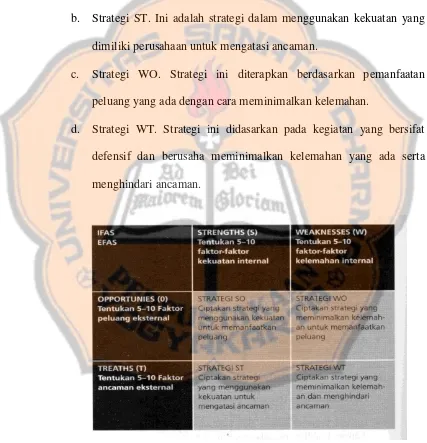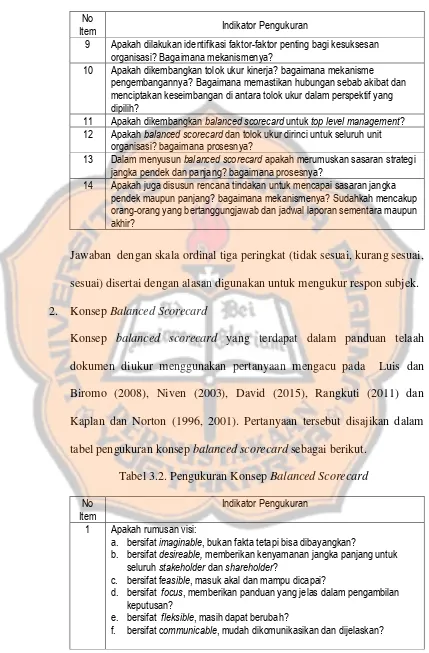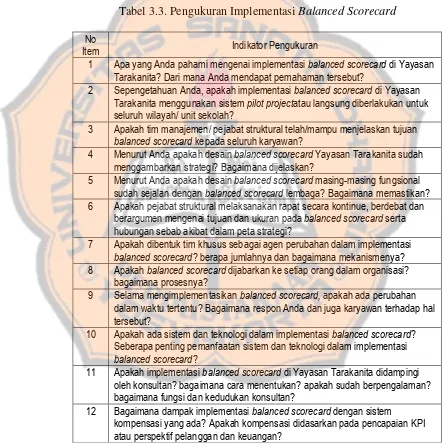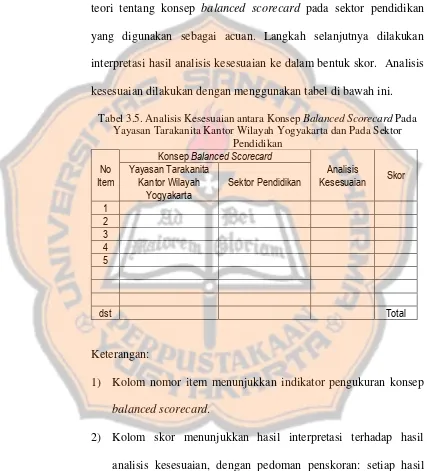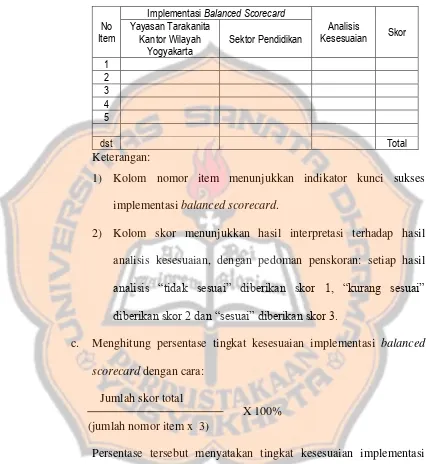I. BAB I PENDAHULUAN
This chapter introduces the research, beginning with a background discussion on the Balanced Scorecard (BSC) and its applications in education, particularly highlighting its successful implementation in various countries and the need for its evaluation in the Indonesian context. The chapter clearly states the research problem, focusing on the suitability analysis of the BSC's development process, concept, and implementation at Yayasan Tarakanita Yogyakarta. This is framed within the existing literature on strategic management in education and the challenges faced by educational institutions in adopting business management models. The research objectives are explicitly stated, aiming to analyze the congruency between the Yayasan's BSC implementation and established best practices in the education sector. The scope and limitations of the research are clearly defined, specifying the units of analysis for each research question.
1.1. Latar Belakang Masalah
This section provides the background of the study, emphasizing the significance of the Balanced Scorecard (BSC) in educational management. It discusses the successful application of BSCs in various countries and its potential benefits. It also highlights the relatively limited adoption of BSCs in Indonesian education and its possible contribution to improving educational management. The section presents data on the performance of Yayasan Tarakanita schools, revealing inconsistencies in academic achievement and student numbers, thus justifying the need for an evaluation of their BSC implementation.
1.2. Rumusan Masalah
This section concisely formulates the research questions, directly addressing the core issue of assessing the suitability of the BSC's implementation at Yayasan Tarakanita Yogyakarta. Three specific research questions are clearly defined, focusing on the alignment between the Yayasan's BSC processes (development, conceptualization, and implementation) with established best practices within the education sector. These questions provide a structured framework for the subsequent analysis and findings.
1.3. Tujuan Penelitian
This section outlines the research objectives, mirroring the research questions. It aims to provide a comprehensive analysis of the congruency between the Yayasan's BSC implementation (development process, conceptual framework, and implementation strategies) and established best practices within the education sector. The objectives are clearly stated and directly address the research problem, setting the stage for the methodological approach to be outlined in the next chapter.
1.4. Ruang Lingkup dan Batasan Penelitian
This section precisely defines the scope and boundaries of the study. It clarifies the units of analysis for each research question, specifying the level of the organization (central office, regional office, and specific schools) involved in the BSC's implementation. The selection of specific schools for detailed analysis is justified based on their contrasting characteristics in terms of student demographics and academic performance, acknowledging the limitations imposed by the research's scale and resources.
1.5. Manfaat Penelitian
This section discusses the theoretical and practical implications of the research. The theoretical contribution lies in enriching the existing body of knowledge on BSCs in educational settings and providing insights for further research in non-business organizations. The practical benefits include providing feedback to Yayasan Tarakanita on their BSC implementation, offering evaluation data for improvements, and aiding schools in understanding and enhancing their BSC utilization. The section articulates the potential impact of the study on various stakeholders.
1.6. Sistematika Penulisan
This section provides an overview of the thesis structure, outlining the content of each chapter. It provides a roadmap for the reader, detailing the flow of the research from the introduction to the conclusion, thereby enhancing the overall clarity and understanding of the research process and findings.
II. BAB II LANDASAN TEORI
This chapter lays the theoretical foundation for the research by exploring relevant theories and concepts. It delves into the definition and application of strategic management in education, highlighting the debates and evolving paradigms surrounding its adoption. The chapter provides a detailed explanation of the Balanced Scorecard (BSC) framework, its four perspectives (financial, customer, internal processes, and learning & growth), and its application in educational settings. It further details the process of developing a BSC in educational contexts, drawing upon existing literature and models. The chapter also examines the key components of a BSC within an educational context, such as vision, mission, SWOT analysis, and strategic planning, providing the theoretical lens through which the empirical data will be analyzed.
2.1. Balanced Scorecard dalam Manajemen Strategis Lembaga Pendidikan
This section defines strategic management and explores its relevance to educational institutions. It discusses the historical context of strategic management in education and addresses the contrasting viewpoints on its suitability within the educational environment. The section introduces the Balanced Scorecard (BSC) as a strategic management system that translates vision and mission into measurable performance indicators, providing a framework for strategic management and implementation. It explains the four perspectives of the BSC and their adaptation within educational contexts, emphasizing the unique challenges and considerations involved.
2.2. Proses Penyusunan Balanced Scorecard Pada Sektor Pendidikan
This section outlines the process of developing a Balanced Scorecard (BSC) in education, drawing on various models and frameworks. It details the steps involved, from defining the vision and mission to identifying key performance indicators (KPIs) and establishing strategic objectives. The section highlights the importance of consensus building, team formation, and the iterative nature of the BSC development process. It emphasizes the importance of aligning the BSC with the organization's overall strategic goals and operational realities.
2.3. Konsep Balanced Scorecard Pada Sektor Pendidikan
This section delves into the key conceptual elements of a Balanced Scorecard (BSC) within the educational context. It emphasizes the interconnectedness of various components, including vision, mission, values, strategic objectives, SWOT analysis, and the selection of appropriate strategies. The section also explores the importance of aligning organizational structure and control systems with the BSC framework. This section critically examines the elements of vision and mission, emphasizing their crucial roles in guiding the development and implementation of the BSC.
III. BAB III METODE PENELITIAN
This chapter describes the research methodology employed in the study. It clearly specifies the research design (evaluative research), data collection methods (documentation, interviews, and document review), and the sample selection criteria (central office, regional office, and two schools). The chapter meticulously explains the data analysis techniques (content analysis) and the triangulation methods used (source and method triangulation) to ensure the reliability and validity of the findings. It also details the variables measured (process, concept, and implementation of the BSC) and the specific instruments used for data collection. The chapter meticulously outlines the research approach, ensuring the rigor and transparency of the research process.
IV. BAB IV TINJAUAN UMUM TERHADAP OBJEK PENELITIAN
This chapter provides a comprehensive overview of Yayasan Tarakanita, the object of the study. It presents a historical background of Yayasan Tarakanita Yogyakarta, details its organizational structure, and describes its core values, vision, and mission. The chapter provides essential context by detailing the organization's resources (human, financial, and physical) and its existing strategic planning processes. It specifically focuses on the implementation of the Balanced Scorecard (BSC) within the Yayasan, providing a detailed description of the existing BSC framework and its integration into the organization's strategic goals.
V. BAB V ANALISIS DATA DAN PEMBAHASAN
This chapter presents the core findings of the research, analyzing the data collected through the methods described in Chapter III. It presents a detailed analysis of the suitability of the BSC's implementation at Yayasan Tarakanita Yogyakarta, focusing on three key aspects: the development process, the conceptual framework, and the implementation strategies. The chapter systematically compares the Yayasan's practices with best practices in the education sector, identifying areas of congruence and divergence. It provides a detailed interpretation of the results, drawing upon the theoretical frameworks presented in Chapter II and offering insights into the factors that contribute to the success or failure of BSC implementation.
VI. BAB VI PENUTUP
This chapter concludes the research by summarizing the key findings, drawing inferences from the analysis presented in Chapter V. It reiterates the main conclusions regarding the suitability of the BSC's implementation at Yayasan Tarakanita Yogyakarta across the three dimensions under investigation. The chapter discusses the limitations of the study, acknowledging factors that might have influenced the findings and suggesting directions for future research. It concludes by offering recommendations for Yayasan Tarakanita to improve their BSC implementation, based on the study's findings and the broader literature on BSCs in education.



